
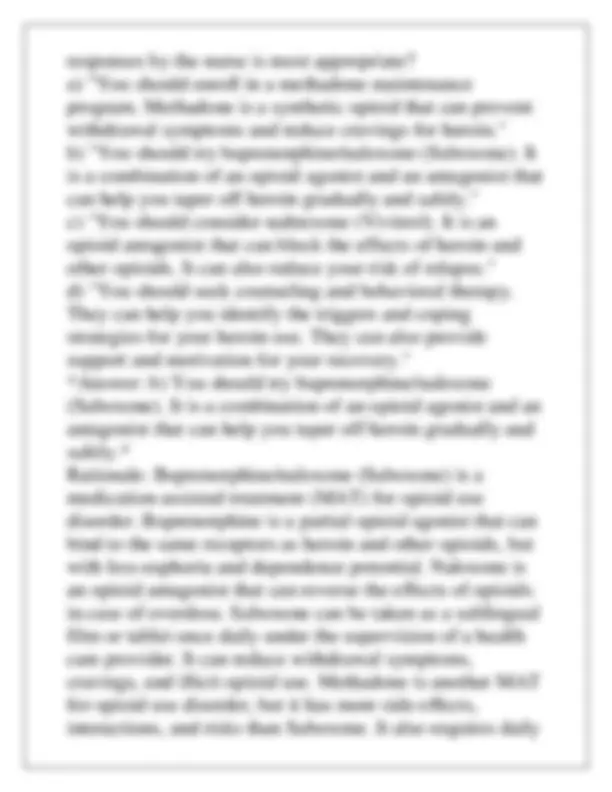
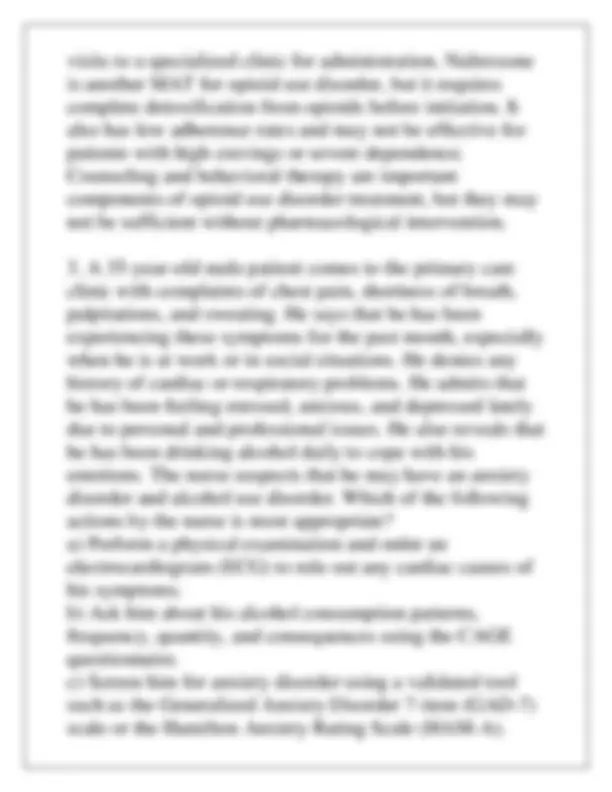
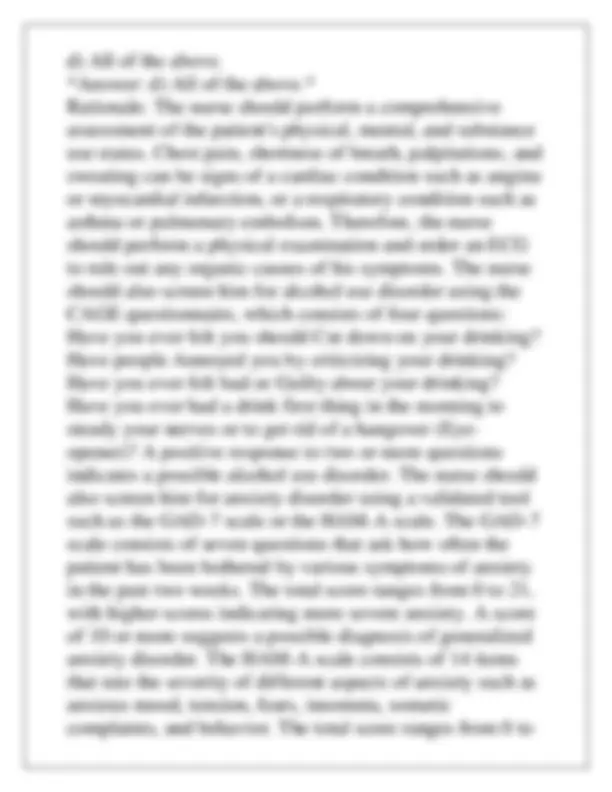
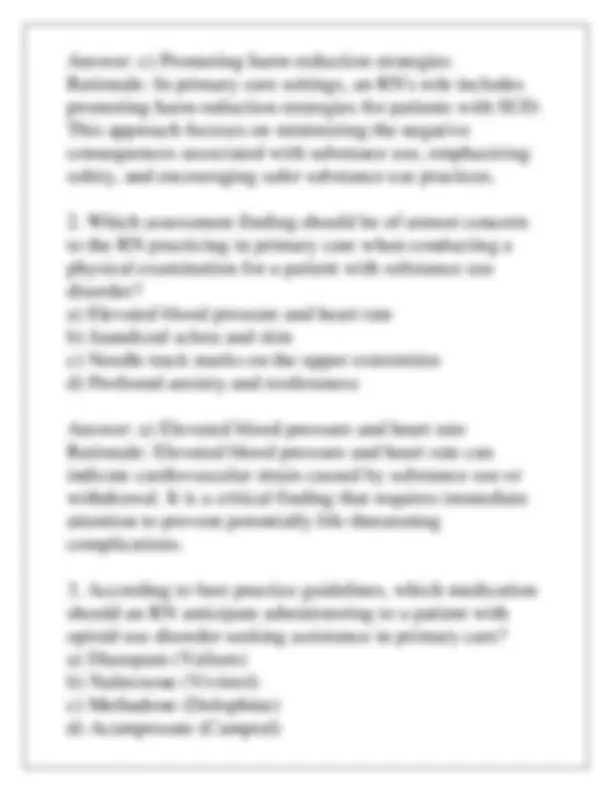
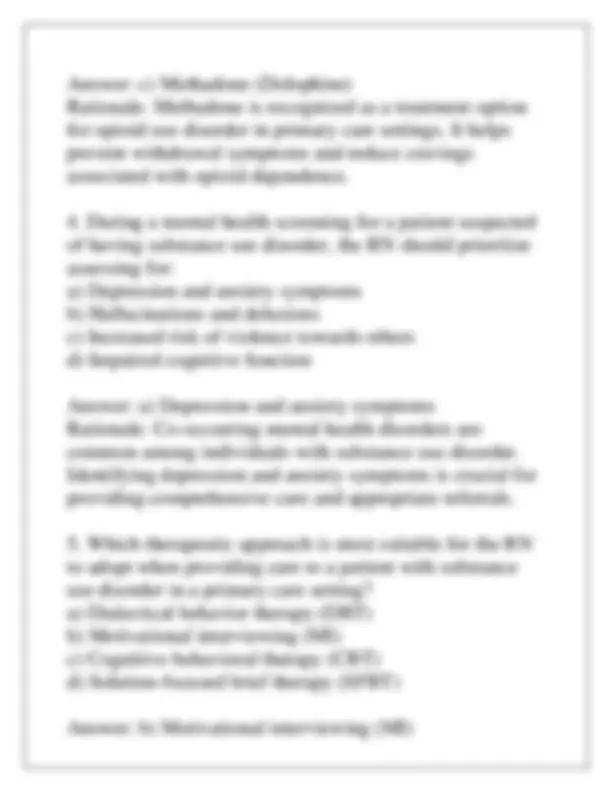
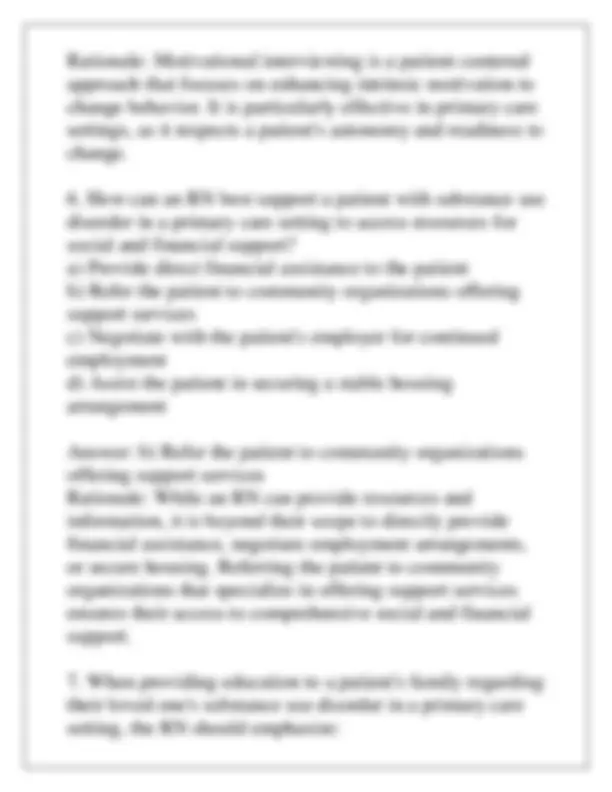
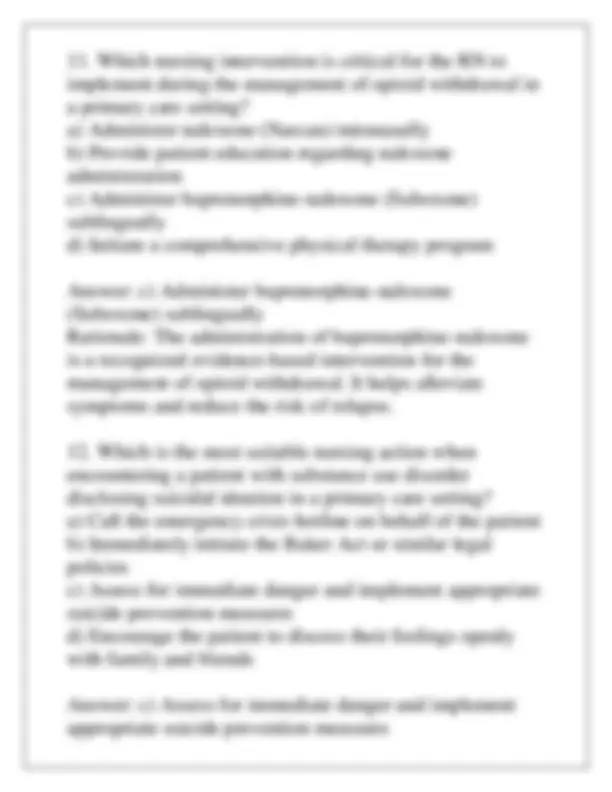
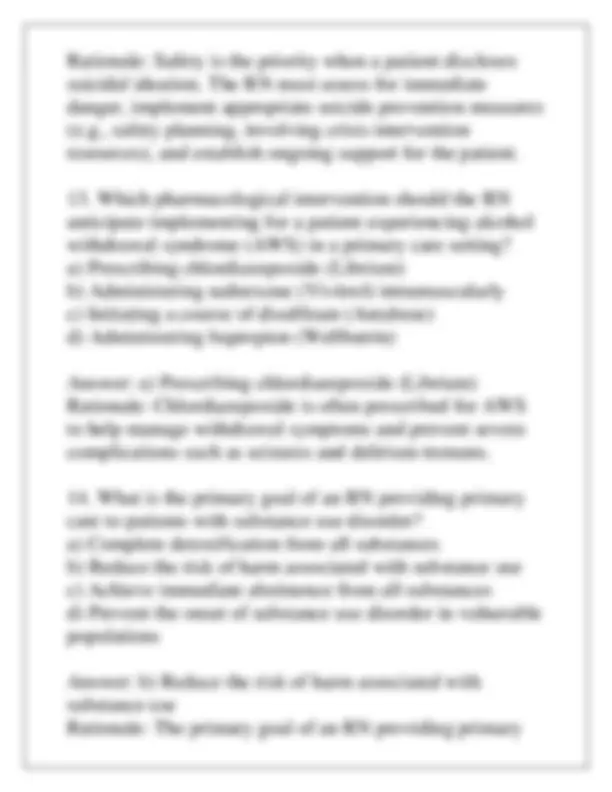
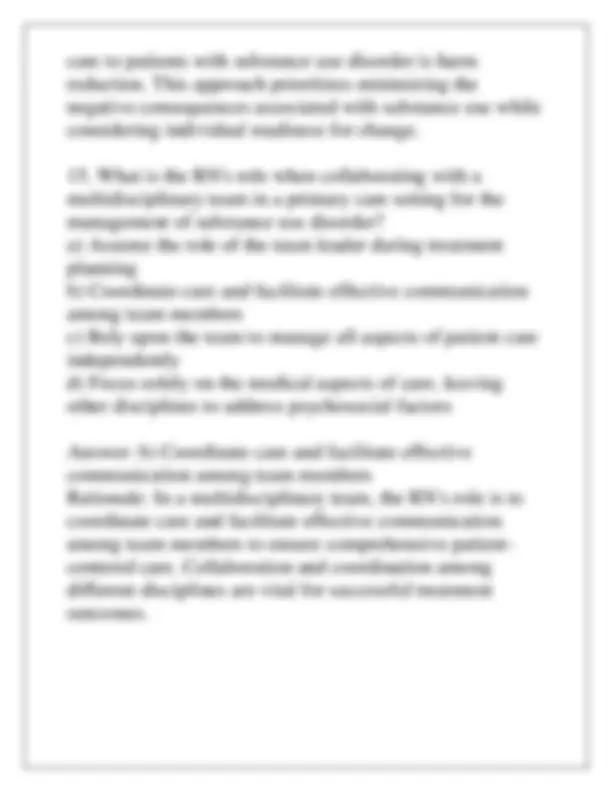
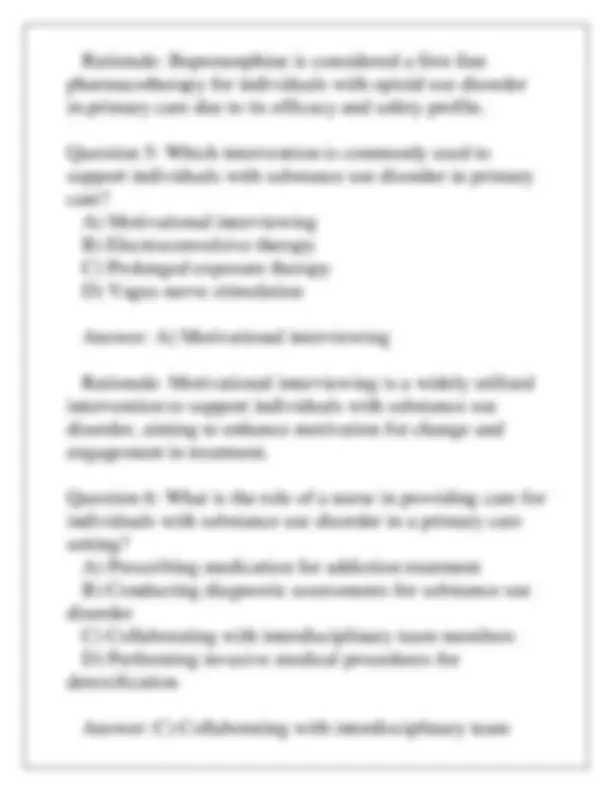
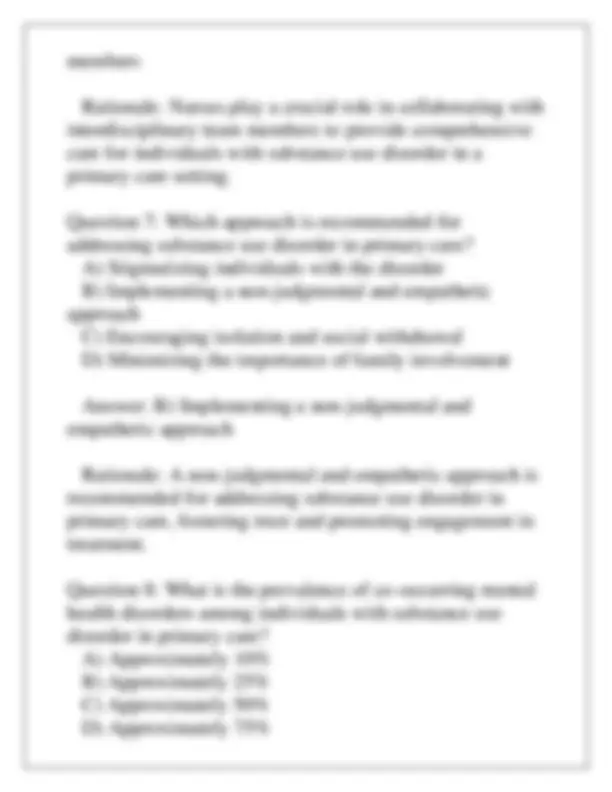
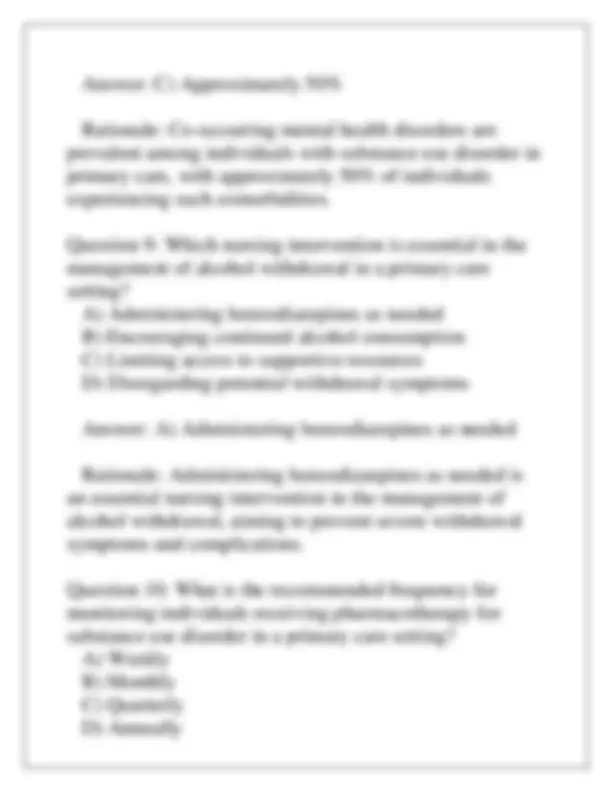
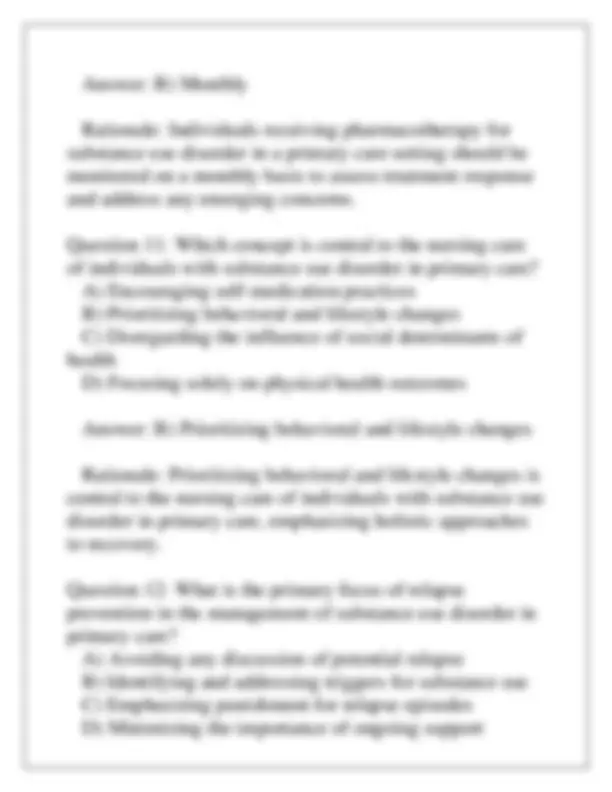
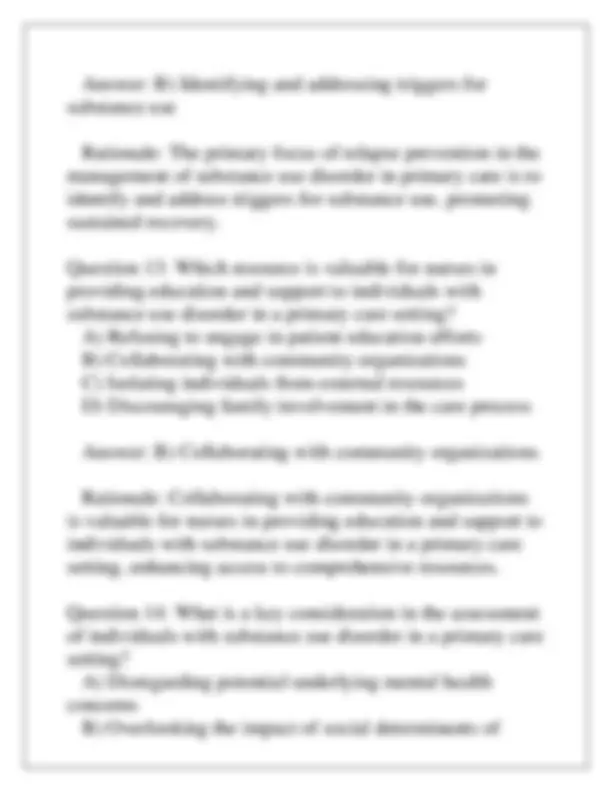
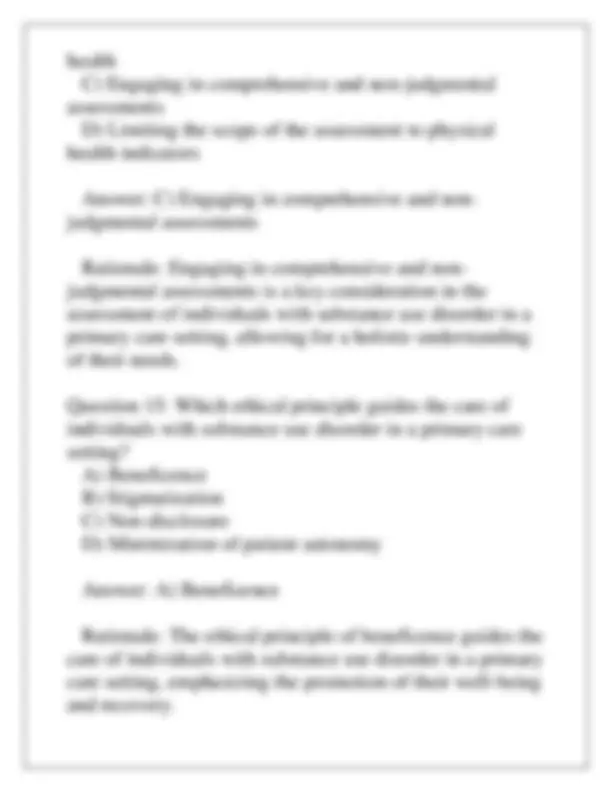


Study with the several resources on Docsity

Earn points by helping other students or get them with a premium plan


Prepare for your exams
Study with the several resources on Docsity

Earn points to download
Earn points by helping other students or get them with a premium plan
Community
Ask the community for help and clear up your study doubts
Discover the best universities in your country according to Docsity users
Free resources
Download our free guides on studying techniques, anxiety management strategies, and thesis advice from Docsity tutors
NRSADVN RN PRACTICE IN PRIMARY CARE & SUBSTANCE USE DISORDER EXAM Q & A 2024NRSADVN RN PRACTICE IN PRIMARY CARE & SUBSTANCE USE DISORDER EXAM Q & A 2024NRSADVN RN PRACTICE IN PRIMARY CARE & SUBSTANCE USE DISORDER EXAM Q & A 2024
Typology: Exams
1 / 23

This page cannot be seen from the preview
Don't miss anything!
















visits to a specialized clinic for administration. Naltrexone is another MAT for opioid use disorder, but it requires complete detoxification from opioids before initiation. It also has low adherence rates and may not be effective for patients with high cravings or severe dependence. Counseling and behavioral therapy are important components of opioid use disorder treatment, but they may not be sufficient without pharmacological intervention.
d) All of the above. Answer: d) All of the above. Rationale: The nurse should perform a comprehensive assessment of the patient's physical, mental, and substance use status. Chest pain, shortness of breath, palpitations, and sweating can be signs of a cardiac condition such as angina or myocardial infarction, or a respiratory condition such as asthma or pulmonary embolism. Therefore, the nurse should perform a physical examination and order an ECG to rule out any organic causes of his symptoms. The nurse should also screen him for alcohol use disorder using the CAGE questionnaire, which consists of four questions: Have you ever felt you should Cut down on your drinking? Have people Annoyed you by criticizing your drinking? Have you ever felt bad or Guilty about your drinking? Have you ever had a drink first thing in the morning to steady your nerves or to get rid of a hangover (Eye- opener)? A positive response to two or more questions indicates a possible alcohol use disorder. The nurse should also screen him for anxiety disorder using a validated tool such as the GAD-7 scale or the HAM-A scale. The GAD- 7 scale consists of seven questions that ask how often the patient has been bothered by various symptoms of anxiety in the past two weeks. The total score ranges from 0 to 21, with higher scores indicating more severe anxiety. A score of 10 or more suggests a possible diagnosis of generalized anxiety disorder. The HAM-A scale consists of 14 items that rate the severity of different aspects of anxiety such as anxious mood, tension, fears, insomnia, somatic complaints, and behavior. The total score ranges from 0 to
diabetes mellitus, hypertension, and hyperlipidemia with her medication regimen and lifestyle modifications. However, she should not stop taking any of her medications without consulting her health care provider. Stopping metformin could lead to an increase in her blood glucose levels and increase her risk of complications such as retinopathy, nephropathy, neuropathy, and cardiovascular disease. Stopping lisinopril could lead to an increase in her blood pressure and increase her risk of stroke, heart attack, heart failure, and kidney damage. Stopping atorvastatin could lead to an increase in her LDL cholesterol and increase her risk of atherosclerosis, coronary artery disease, and peripheral artery disease. Therefore, the nurse should advise the patient to continue taking all her medications as prescribed to maintain her health outcomes and prevent any adverse events. B:
Answer: c) Promoting harm reduction strategies Rationale: In primary care settings, an RN's role includes promoting harm reduction strategies for patients with SUD. This approach focuses on minimizing the negative consequences associated with substance use, emphasizing safety, and encouraging safer substance use practices.
Rationale: Motivational interviewing is a patient-centered approach that focuses on enhancing intrinsic motivation to change behavior. It is particularly effective in primary care settings, as it respects a patient's autonomy and readiness to change.
a) Enabling behaviors can worsen the condition b) Impose strict rules and consequences for relapses c) Publicly shame and stigmatize the patient's behavior d) Withdrawing emotional support as a form of punishment Answer: a) Enabling behaviors can worsen the condition Rationale: By emphasizing that enabling behaviors can worsen the patient's condition, the RN educates the family on the importance of avoiding behaviors that inadvertently support the addiction cycle. Encouraging healthy boundaries and seeking appropriate support are positive strategies for family members.
Rationale: Safety is the priority when a patient discloses suicidal ideation. The RN must assess for immediate danger, implement appropriate suicide prevention measures (e.g., safety planning, involving crisis intervention resources), and establish ongoing support for the patient.
Question 1: Which of the following is a characteristic of substance use disorder? A) A pattern of use that leads to impairment or distress B) Occasional use without negative consequences C) Controlled use without escalation D) Social use without impact on daily functioning Answer: A) A pattern of use that leads to impairment or distress Rationale: Substance use disorder is characterized by a pattern of use that results in impairment or distress, indicating the presence of a significant problem with substance use. Question 2: What is the primary goal of nursing care for individuals with substance use disorder in a primary care setting? A) Enabling continued substance use in a controlled manner B) Providing harm reduction strategies C) Facilitating complete abstinence from substances D) Minimizing the impact of substance use on daily life Answer: C) Facilitating complete abstinence from substances
Rationale: In a primary care setting, the primary goal of nursing care for individuals with substance use disorder is to facilitate complete abstinence from substances, promoting long-term recovery and improved health outcomes. Question 3: Which screening tool is commonly used by primary care providers to assess for substance use disorder? A) CAGE questionnaire B) PHQ- 9 C) Modified Checklist for Autism in Toddlers (M- CHAT) D) Geriatric Depression Scale (GDS) Answer: A) CAGE questionnaire Rationale: The CAGE questionnaire is a widely used screening tool in primary care settings to assess for potential issues related to alcohol use disorder. Question 4: What is the first-line pharmacotherapy for individuals with opioid use disorder in primary care? A) Naltrexone B) Methadone C) Buprenorphine D) Disulfiram Answer: C) Buprenorphine
members Rationale: Nurses play a crucial role in collaborating with interdisciplinary team members to provide comprehensive care for individuals with substance use disorder in a primary care setting. Question 7: Which approach is recommended for addressing substance use disorder in primary care? A) Stigmatizing individuals with the disorder B) Implementing a non-judgmental and empathetic approach C) Encouraging isolation and social withdrawal D) Minimizing the importance of family involvement Answer: B) Implementing a non-judgmental and empathetic approach Rationale: A non-judgmental and empathetic approach is recommended for addressing substance use disorder in primary care, fostering trust and promoting engagement in treatment. Question 8: What is the prevalence of co-occurring mental health disorders among individuals with substance use disorder in primary care? A) Approximately 10% B) Approximately 25% C) Approximately 50% D) Approximately 75%
Answer: C) Approximately 50% Rationale: Co-occurring mental health disorders are prevalent among individuals with substance use disorder in primary care, with approximately 50% of individuals experiencing such comorbidities. Question 9: Which nursing intervention is essential in the management of alcohol withdrawal in a primary care setting? A) Administering benzodiazepines as needed B) Encouraging continued alcohol consumption C) Limiting access to supportive resources D) Disregarding potential withdrawal symptoms Answer: A) Administering benzodiazepines as needed Rationale: Administering benzodiazepines as needed is an essential nursing intervention in the management of alcohol withdrawal, aiming to prevent severe withdrawal symptoms and complications. Question 10: What is the recommended frequency for monitoring individuals receiving pharmacotherapy for substance use disorder in a primary care setting? A) Weekly B) Monthly C) Quarterly D) Annually